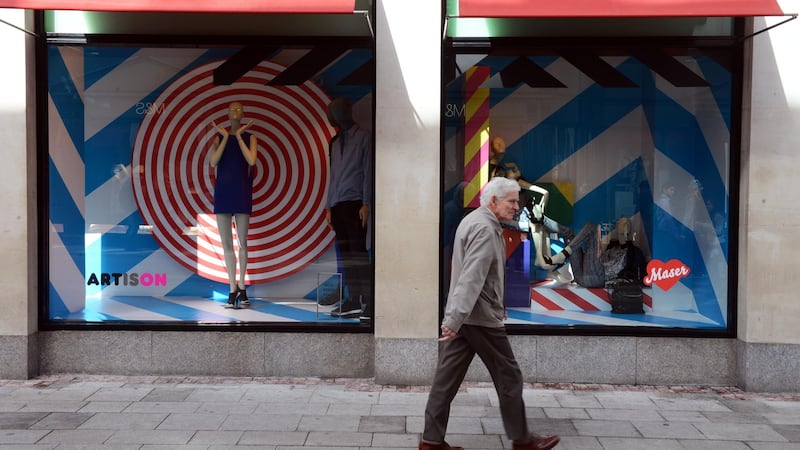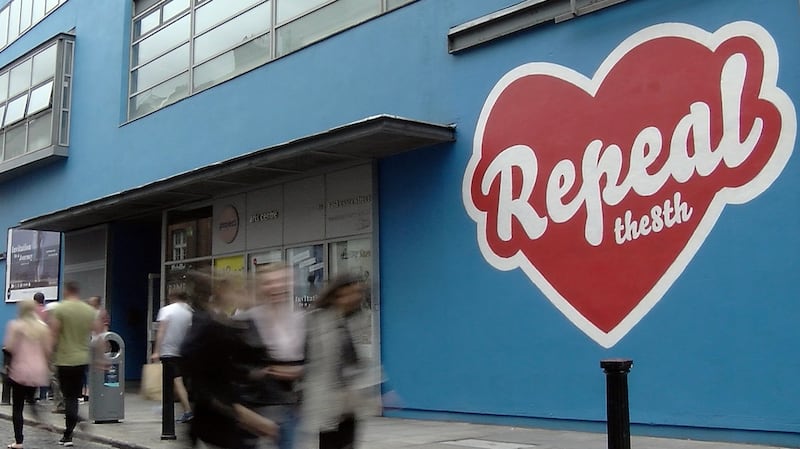The street artist Maser is wearing a paint-stained plaid shirt and is contemplating three of the brightly-coloured fine art prints he has created for an exhibition at the Graphic Studio Gallery in Temple Bar.
"He's changed his mind on these frames," says his friend and collaborator, carpenter and model-maker Eoin Murphy.
“They’re too woody,” he says. “I want them whiter.”


“Is he a bit of a prima donna?” I ask and they laugh.
Maser has come from etching his name on Dublin’s backstreets to being a controversial public artist contemplating the whiteness of his frames in a fine art gallery.
“I don’t think the term ‘street art’ was even around in 1995 when I started,” he says. “It was just graffiti. It wasn’t as glamorous as people think. It was just me, 15 years old, nervously down an alley writing my name on a door in marker.”
What was the appeal? He’d always loved art, but “[graffiti] was a sociable thing. You were out with your friends. You got to explore the city and it was a rebellious thing . . . Why do we do anything? Maybe it’s because we never want to be forgotten. Maybe we want to live forever. Maybe we want to leave our mark so that if you do die something stays behind . . . Maybe it gave me relevance.”
He was inspired by older graffiti artists such as John O'Reilly and he knew about aerosol art's Philadelphia roots and its New York hip-hop legacy, though he was as likely to listen to Jimi Hendrix and the Doors as hip hop. "I was definitely more into it for the art component than for the hip-hop subculture thing. But even just the act of painting outdoors is political. Painting a mural where you're not meant to be. That says a lot."
Sometimes he sounds nostalgic as he recalls it. “There’s something about going off with your friends, packing a lunch and bringing fresh socks and going off to an abandoned reservoir and spending a whole day painting and being exhausted and having your photos and making those memories.”
At other times, he sounds glad to be away from it. “I don’t have the energy for it [anymore],” he says and laughs. “I’m just getting old . . . We did street art because we had no other option. I always wanted to spend time on a piece which isn’t always possible when you’re doing it illegally. I was already doing portraits and figurative work [then] and I was trying to transcribe them on to walls . . . I’d already seen a huge index of work of spray can art so I knew it was an art form and not just graffiti.”
Fine art
In the past he was uncomfortable with the fine art world. “I went to study fine art and I hated it so I dropped out. And then I went back to being a commis chef and studied visual communications, mainly typography, and I loved it. I merged typography and graffiti and we set up a collective called Crooked Type and did signwriting or video making for people.”
Why did he hate art college? He sighs. “It’s just full of shit,” he says. “I had spray paint cans and there was a lot of snobbery. There were other students [with artistic theories] and I’d go ‘I know you’re just bullshitting.’ I thought, I’m not going to try and please these people if they believe this bullshit.”
Long after he started doing public art projects, working with authorities rather than trying to evade them, he says he was still "embarrassed" to call himself an "artist". He recalls doing a piece in Sydney's Hyde Park where a crane was needed to move the components of the piece. "Jeff Koons was the artist there before me and you're thinking 'I'm just this kid from Dublin.'"
When did he first look at his work and think, that's art? "I think it was when we did the thing in 2009 working with the musician Damien Dempsey, " he says, "a project called They Are Us for the homeless, and we finished painting the nine-storey block of flats in Ballymun. I was sitting at the Ballymun shopping centre thinking, this is good shit."
Has street art become respectable? He and Murphy discuss the rise of graffiti jams and mural projects. “There was a big shift a few years ago,” says Maser. “There were more mural projects happening and people were appreciating it more as public art.”
“It’s become a really good excuse in some areas to cover something up,” says Murphy.
“Yeah, a cheap and cheerful way to hide things,” says Maser.
“It’s a lot cheaper than fixing it,” says Murphy.
“Cities do that all the time,” says Maser. “The downtown area is destroyed, let’s send in a load of artists down and then the coffee shops will come.”
Prettification
In fact, one of his most enjoyable pieces was devised as a way to prettify a derelict petrol station in Limerick. “They had this hoarding at the front of the petrol station on the street, ‘Will you paint this to hide the petrol station?’ But I said ‘The petrol station is brilliant, if we could clean it, I could do something with it.’ And then bingo I’ve made an experiential painting.”
He’s aware that both the fine art world and the corporate world can get vicarious radicalism from working with street artists. “Brands buy into it because it makes them look cool. But what’s wrong with that? Why can’t we enjoy the benefits of that too?”
A few years ago, he worked on a set of typically bold and bright abstract designs for Brown Thomas’ windows on Grafton Street. Why did he do that? “There was a nice bit of wedge in it,” he says. “And it was great to do. I was a designer and you get to design these windows. I used to work in a skate shop where I did the windows all the time and there’s a nostalgic element. I used to go to the Switzer’s windows as a kid with my ma every Christmas. We’d go for lunch in town first and then look at the windows. I had the opportunity to do that again with my own windows. I went for lunch with my ma and went to look at the windows.”
He pauses for a moment and thinks. “Going back to the graffiti artist thing,” he says. “You try to do prominent work where people see it. I got to do the best windows on the busiest street in Dublin. It was a no-brainer. I thought it was cool.” He laughs. “So I don’t really give a shit if someone has an issue with it.”
Political edge
Much of his work still has a political edge. Recently his Repeal the Eighth mural on the wall of Dublin's Project Arts Centre, which arose after a conversation with his friend Andrea Horan, caused controversy when anti-abortion campaigners complained and it was removed for contravening planning regulations.
“I knew there’d be opinions and I wanted to be sure I was clear on my opinion and I had a good chat with my mum and my sister about it and that confirmed I was doing the right thing,” he says. “My mother was straight up, ‘Imagine you trying to tell me what to do with my body.’ I was like ‘You’ve got that right.’” He laughs. “So I painted it. I didn’t really speak about it or push it and it took a life of its own, which is what public art is meant to do.” Did he expect it to be removed? “I did, yeah. Thank God for social media. If we didn’t have that I’d be a bit disappointed. It got shared thousands of times, job done.”
Social media is now a huge part of how public art gets an audience. “When we started doing graffiti we would post letters with photos to guys we knew in London and they’d send us photos of their most recent pieces,” he says. “That’s how you used share it.”
Public artwork will, he says, always be a “billboard” for his gallery work, but after years of hopping around the world (he lived in Arkansas for two years), he has retreating to his London studio to do some painting and print work for a while. It’s partly because after a career working publicly, the idea of being an artist in a garret appeals to him. But it’s also about creating something that lasts, he says. “You put a lot of time and energy into these large installations and they’re not permanent . . . you’d like some stuff that was still around.”
He talks a little about how he created the fine art prints in the exhibition using wood blocks made with Murphy. He jokes about the gallery having a stash of "fizzy water". His favourite Irish artists are people with a populist touch like Jim Fitzpatrick – who is launching the exhibition – and Robert Ballagh. His friends are largely "regular heads", he says, rather than art world people.
Did he always want to be a professional artist? “No,” he says. “And that’s the thing. Even if it all goes tits up next year, I’ll go back to being a commis chef, to washing dishes. I’ll just think, that was a great run.”
A collection of Maser’s new work can be seen in the Graphic Studio Gallery in Temple Bar, Dublin and on November 19th he is giving a lecture on printing as part of the View Temple Bar festival
![Street artist and print maker Maser: “[Graffiti] was a sociable thing. You were out with your friends. You got to explore the city and it was a rebellious thing”. Photograph: Eric Luke](https://www.irishtimes.com/resizer/v2/TA6QJL6KUTEWYRAUSLYX4RBRC4.jpg?auth=22e904125b016de36b2bb7cbd0bdc8b07fa925ce164468ae828d53daf1f46dd4&smart=true&width=1024&height=576)










